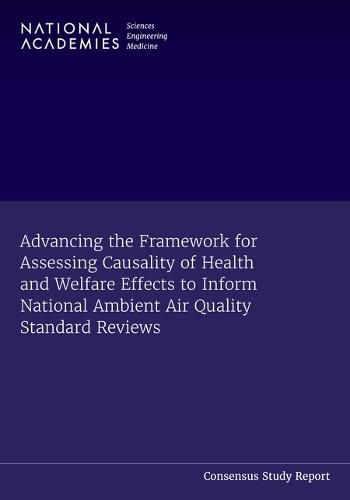Advancing the Framework for Assessing Causality of Health and Welfare Effects to Inform National Ambient Air Quality Standard Reviews
National Academies of Sciences, Engineering, and Medicine, Division on Engineering and Physical Sciences, Division on Earth and Life Studies, Board on Mathematical Sciences and Analytics, Board on Environmental Studies and Toxicology, Committee on Assessing Causality from a Multidisciplinary Evidence Base for National Ambient Air Quality Standards

Advancing the Framework for Assessing Causality of Health and Welfare Effects to Inform National Ambient Air Quality Standard Reviews
National Academies of Sciences, Engineering, and Medicine, Division on Engineering and Physical Sciences, Division on Earth and Life Studies, Board on Mathematical Sciences and Analytics, Board on Environmental Studies and Toxicology, Committee on Assessing Causality from a Multidisciplinary Evidence Base for National Ambient Air Quality Standards
As part of its responsibilities under the Clean Air Act, the U.S. Environmental Protection Agency sets National Ambient Air Quality Standards (NAAQS) for the air pollutants carbon monoxide, lead, oxides of nitrogen, particulate matter, ozone, and sulfur dioxide. EPA uses a "weight of evidence approach" to evaluate evidence from scientific studies and describe the causal relationships between these "criteria pollutants" and any adverse impacts on human health and on public welfare - including impacts on wildlife, water, forests, agriculture, and climate. The evaluation, called an Integrated Science Assessment, is used to inform standards setting associated with the criteria pollutants.
This report, produced at the request of EPA, describes EPAs and several other frameworks for inferring causality of health or welfare effects and the characteristics of evidence useful for forming a causal determination. The report concludes that EPAs causal framework is effective, reliable, and scientifically defensible, provided that key scientific questions are identified and a range of necessary expertise is engaged. More transparency in how EPA integrates evidence could improve confidence in their determinations, and more guidance is needed in the framework on how evidence should be examined for vulnerable groups (e.g., human sub-populations) and sensitive ecosystems or species.
Table of Contents
Front Matter Summary 1 Introduction 2 Historical and Legal Perspectives on the NAAQS Framework for Assessing Causality 3 Definition of Causality 4 Influence of the Individual Study on the Body of Evidence 5 Evidence Synthesis in Integrated Science Assessments 6 Example Critiques of the ISA Process and Causal Determination Framework 7 Illustrative Frameworks for Causal Determinations 8 Emerging Methods for Observational Studies Contributing to Causal Determinations 9 Use of the Framework to Assess Both Health and Welfare Effects 10 Conclusions and Recommendations References Appendix A: Committee Member Biographies Appendix B: Open Session Agendas Appendix C: Introduction to Causal Inference Principles
This item is not currently in-stock. It can be ordered online and is expected to ship in approx 4 weeks
Our stock data is updated periodically, and availability may change throughout the day for in-demand items. Please call the relevant shop for the most current stock information. Prices are subject to change without notice.
Sign in or become a Readings Member to add this title to a wishlist.


